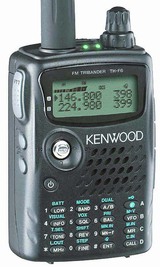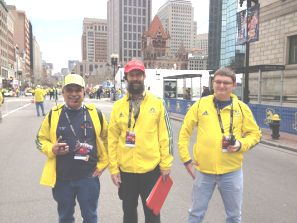Public Service and Emergency Communications Go-Kit

For Public Service and Emergency Communications, I use a Kenwood TH-F6A VHF/UHF handheld transceiver. It is a very compact HT measuring 2.3" x 3.4" x 1.2" and it meets military specs for ruggedness. It weighs only half a pound with the battery pack and covers the 145MHz, 220 MHz and 440 MHz Amateur Radio bands with 5 watts output power. The TH-F6A has a second, wide band, general coverage receiver that covers from 100 kHz to 1.3 GHz.
It is powered by Lithium-ion battery pack. I have both the AC charger and a Kenwood car cigarette lighter cable for charging the Li-ion pack. I also have an AA battery pack that uses four AA alkaline batteries, but the transmitter output power is reduced to only half a watt with the AA pack.
I could switch to the AA battery pack if the Li-ion pack runs out of power, but that has never happened since the transmitter duty cycle is low at public service events. The receiver only draws 100ma in single band mode and only 30ma with the battery saver circuit engaged. The transmitter draws 2 amps at high power. Kenwood estimates 6.5 hours operating time with normal duty cycles at 5 watts on 2 meters when the battery is fully charged.
The TH-F6A comes with a 7 1/2 inch rubber duck antenna with an SMA connector. I replaced it with a rubber Jetstream JT776SMA antenna that is 16.1 inches long. This antenna acts a full 1/4 wave antenna on 144 MHz and 223 MHz and a 1/2 wavelength on 440MHz. It is a little more unwieldy than the smaller antenna, but it has a more gain. I also carry a 2 Meter, quarter wave, 19" vertical magnetic mount antenna with me.
It is powered by Lithium-ion battery pack. I have both the AC charger and a Kenwood car cigarette lighter cable for charging the Li-ion pack. I also have an AA battery pack that uses four AA alkaline batteries, but the transmitter output power is reduced to only half a watt with the AA pack.
I could switch to the AA battery pack if the Li-ion pack runs out of power, but that has never happened since the transmitter duty cycle is low at public service events. The receiver only draws 100ma in single band mode and only 30ma with the battery saver circuit engaged. The transmitter draws 2 amps at high power. Kenwood estimates 6.5 hours operating time with normal duty cycles at 5 watts on 2 meters when the battery is fully charged.
The TH-F6A comes with a 7 1/2 inch rubber duck antenna with an SMA connector. I replaced it with a rubber Jetstream JT776SMA antenna that is 16.1 inches long. This antenna acts a full 1/4 wave antenna on 144 MHz and 223 MHz and a 1/2 wavelength on 440MHz. It is a little more unwieldy than the smaller antenna, but it has a more gain. I also carry a 2 Meter, quarter wave, 19" vertical magnetic mount antenna with me.
I keep the transceiver in a padded leather pouch so that it is protected in my backpack. When I am using the HT, I attach it to my belt with its built in belt clip. The spring clip is very strong and it has never failed. The two Phillip screws that attach it to the radio loosen up after awhile, so I carry a small Phillips screwdriver to tighten them. I also carry a small straight screwdriver that I use to disconnect the battery pack that is attached with a spring clip that is hard for to push with my fingers. I keep these screwdrivers, along with a small Leatherman type multi-tool, in a small zipper canvas bag. I also carry two Nifty Guides (Basic and Advanced) for the TH-F6A. I keep a pdf copy of the manual on my iPhone.
The transceiver has over 400 memory channels available for programming. The programming, like all handheld transceivers, is not simple since each memory channel has to be set for band, frequency, offset (if a repeater channel), PL tone and ID number. I have the RTS Systems computer software and cable that attaches from the radio to a PC. This programming method is easier, however, I like to stay current on how to program a memory channel using only the keypad since, based on my past experience at many public service events, I often need to change frequencies, tones, etc. "on the fly."
I carry a speaker microphone and a separate pair of headphones that plug into the speaker mic. I use a pair of Panasonic folding, over the ear, padded headphones. If I do not want to cover both ears, I use a one-piece wire frame headset that has a small boom microphone and a single headphone that fits on top of the left ear. It's a bit complicated but it usually works out fine. All of this gear plus some other necessities such as Granola Bars, Post-It Notes, pens, paper, and an ARRL Repeater Directory, all fit into my ARRL Backpack.
The transceiver has over 400 memory channels available for programming. The programming, like all handheld transceivers, is not simple since each memory channel has to be set for band, frequency, offset (if a repeater channel), PL tone and ID number. I have the RTS Systems computer software and cable that attaches from the radio to a PC. This programming method is easier, however, I like to stay current on how to program a memory channel using only the keypad since, based on my past experience at many public service events, I often need to change frequencies, tones, etc. "on the fly."
I carry a speaker microphone and a separate pair of headphones that plug into the speaker mic. I use a pair of Panasonic folding, over the ear, padded headphones. If I do not want to cover both ears, I use a one-piece wire frame headset that has a small boom microphone and a single headphone that fits on top of the left ear. It's a bit complicated but it usually works out fine. All of this gear plus some other necessities such as Granola Bars, Post-It Notes, pens, paper, and an ARRL Repeater Directory, all fit into my ARRL Backpack.
